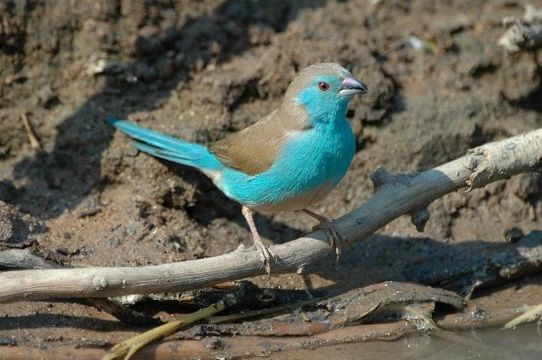
Cordon Bleu Finches
The Cordon Bleu family of finches contains five very different species of finch. They are typically seed eaters, eating small insects when breeding.
Blue capped Cordon Bleu
The Blue capped Cordon Bleu (Uraeginthus cyanocephalus) originally comes from Ethiopia, Kenya, Somalia, Sudan and Tanzania in eastern Africa. It lives in tropical grassland areas as well as shrubland and desert habitats. They are usually around 5 inches in length, and the male is brighter in colour with a blue cap. The females are duller with less blue on the head.
They feed on a foreign finch mix in captivity as well as weed seeds and seeding grasses but need live food to raise their young.
The Blue capped is one of the most commonly bred waxbills in aviculture and reliably raise young with only a small amount of live food. They will nest in typical finch boxes or even build in vegetation with grasses, coconut fibres and lined with feathers. 4-6 eggs are laid and incubated for 11 days, with chicks fledging at around 18 days.
Red-cheeked Cordon-Bleu
The Red-cheeked Cordon Bleu (Uraeginthus bengalus) lives in the drier areas of sub-Saharan Africa than its Blue capped cousins. It will live in nearly any habitat save forest interiors and are found in family groups or pairs flying from low bush to bush.
It is slightly larger at 4.9-5.1 inches in length with the male being brown on the upper parts with a blue breast, flanks and tail. There are red patches on either of his cheeks which do not appear on the female, who is also duller in colour.
They feed on the ground and eat seeds but also a good amount of live food such as mini mealworms or buffalo worms. This live food requirement is strongest when rearing chicks.
In captivity, it is a popular bird but it does need some guarding against lowest temperatures, mainly due to it roosting on perches rather than in a nest.
When breeding, males can be aggressive with each other and if disturbed, can abandon the nest. 3-6 eggs are laid and hatch after around 11 days, fledging from the nest at 17-19 days old.
Purple Grenadier
The Purple Grenadier (Uraeginthus ianthinogaster) is a startling finch around 5 inches in length. The male has a cinnamon coloured head and neck with blue feathers around his eyes while the rest of the body is purplish blue. The female is mostly cinnamon brown with white barring and silvery blue eye patches. They both have red beaks.
In the wild, these birds live in Ethiopia, Kenya, Somalia, Sudan, Tanzania and Uganda where they live in tropical dry shrubland areas.
Grenadiers can live happily with other species of finch, but not with other closely related Cordon Bleu species discussed here as they can be aggressive. They need heat in our climate so either indoors during the winter or a heated and sheltered bird house.
These birds will nest in shrubs or bushes and construct a nest from coconut fibre, grass and feathers. Like other species of this family, they need live food to rear young. 3-5 eggs are laid, incubated for around 12-14 days and fledge at 21 days. They are fed by their parents for around another two weeks after this.
A tip given to me was make sure if breeding these birds that they nest in an open nesting pan where they can see the chicks, as the chicks are mute when born and the parents cannot hear them begging, so need to be able to see them.
Blue Waxbill
The Blue Waxbill (Uraeginthus angloensis) is often known as the Blue-breasted Cordon Bleu and is a common finch across southern Africa.
In the wild, these birds are found in pairs or small flocks with other seedeaters. They occupy woodlands and shrubby grassland where they feed on insects and seeds. The male is light blue on the face and upper breast with brighter blue on the belly while, on the female, this is more brown.
Violet Eared Waxbill
The Violet Eared Waxbill (Uraeginthus granatinus) is also known as the Common Grenadier and lives across the drier areas of southern Africa. The male has purple-blue feathers around his face with a red bill, and the rest of his feathers are a deep brown with lighter brown underparts. The females are lighter in shade and have a shorter tail but are otherwise similar.
As well as a good basic foreign finch seed mix, these birds eat more live food than nearly any other waxbill so this should be provided all year round as well as adding a softbill specialist food on occasions.
These birds are not the hardiest of finches and will need to be inside during the coldest months or with a heated shelter at all times if kept outside. Nor are they the friendliest birds, and will not tolerate living with other birds of the same species or even those closely related discussed here.
They build a rounded nest with grass stems and line with feathers with a side entrance. 2-5 eggs are laid which hatch at 13 days approximately and remain in the nest up to three weeks. Live food is crucial when chicks are being reared, or they will not survive. Breeding can be difficult in the UK as parents often sleep outside the nest after the first week which can kill the chicks if the weather suddenly turns cold.
Conclusion
These stunning little birds may not be the friendliest with other members of their family, but mix fine with other species of finch. They are active and cautious, as is common with many small birds, but are a pleasure to watch as they are rarely inactive. They vary from species to species in breeding results so may be worth starting with the easier ones before moving on to the Grenadier or Purple Eared but a definitely attractive and interesting addition to any finch collection.



